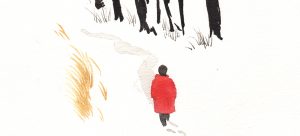
The End of the World as We Know It!
Periods of change bring on the jitters — until we all feel fine again
The new year brings some changes to the American landscape, and periods of change are often fraught with concern and fear. Of course books and literature provide plenty of opportunities to examine life on the brink of apocalypse, and sometimes offer ways to walk back from the precipice. And sometimes they dive right into the abyss.
Joseph Conrad’s Heart of Darkness (Penguin Classics, $15) is a novel that goes over the edge. It was the source material for Francis Ford Coppola’s 1979 film Apocalypse Now, which aptly transports the corrosive colonialism at the heart of Conrad’s work to Vietnam. Also at the heart of Conrad’s work, as Nigerian novelist Chinua Achebe has noted, is a casual racism. Black British novelist Caryl Phillips said in 2003 that, “Achebe is right; to the African reader the price of Conrad’s eloquent denunciation of colonization is the recycling of racist notions of the ‘dark’ continent and her people.”
The view from the brink has never been better than in Elizabeth Kolbert’s The Sixth Extinction: An Unnatural History (Picador, $16). Neither hopeless nor naively optimistic, Kolbert offers a pragmatic synthesis of how we know what we know about Earth’s major extinction events and what we can do to minimize the scope of impending mass die-offs in our time. Don’t be dissuaded by the dark subject matter. The next major extinction is coming, but we have the power to decide how extensive it will be. In this gap between denial and despair lies the hope for our species. This is required reading for all realistic citizens of the 21st century.
In Roberto Bolano’s 2666 (Picador, $23) more than 250 pages are devoted to the constant and random murders of women in Juarez, Mexico. The chapter is called, “ The Part About the Crimes.” Ostensibly concerned with the lives of a few Mexican policemen attempting to work with the murders as well as the messy details of their own lives, “The Part About the Crimes” eventually becomes an ongoing list of how the women were murdered, who they were, where their bodies were found, and how they were dressed when found. These murders are never solved (as they usually aren’t in Juarez and as many murders never are) but the fidelity and humanity with which Bolano ruthlessly documents each one builds to an experience in the reader of what political philosopher Hannah Arendt called “the banality of evil” — the slow accretion of horror that gradually overtakes a culture, becoming commonplace.
A handy all-in-one guide to late 20th-century leftist apocalyptic thought is available in the collection of essays called Apocalypse Culture (Feral House, $15). The book is a reminder that doomsayers have long been part of American subculture, and this compendium juxtaposes reasoned looks at political culture at the breaking point alongside unhinged predictions of imminent demise. For a fundamentalist look at imminent demise, there’s LaHaye and Jenkins’ series of Left Behind books. For those of us left behind by the rapture, we can only hope that the books themselves are not left with us.
For a much more tender look at the end of time, try Ted Mooney’s beautiful novel of atomic war, Traffic & Laughter (Vintage, $23):
“You know what?” she said, meeting his gaze. “I’m not ready for this.”
“Well, of course not,” he replied. In the context, the notion of preparedness made him indignant. “Who’s ready to see their world go up in a cloud of smoke?” It seemed to Michael that she was smiling at him. “I wasn’t talking,” she said, “about the world.”
No novelist moves us quite like Ted Mooney; his work is a reminder that all our lives are worth saving and art is one way we save lives. To the future!
NEW RELEASES FOR JANUARY 2016
The publishing industry takes a bit of a break in January as it recovers from the holiday mad dash, but still a few notable books usher in 2017:
January 3: Let Them Eat Chaos, by Kate Tempest (Bloomsbury, $16). Tempest’s powerful new narrative poem — set to music on her album of the same title — illuminates the lives of a single city street, creating an electric, humming human symphony.
January 10: Washington’s Farewell: The Founding Father’s Warning to Future Generations, by John Avlon (Simon & Schuster, $27). George Washington’s Farewell Address was a prophetic letter from a parting friend to his fellow citizens about the forces he feared could destroy our democracy: hyper-partisanship, excessive debt and foreign wars.
January 17: My Life, My Love, My Legacy, by Coretta Scott King (Henry Holt & Co., $30). The life story of Coretta Scott King, wife of Martin Luther King Jr., founder of the Martin Luther King Jr. Center for Nonviolent Social Change (The King Center) and singular 20th-century American civil and human rights activist as told fully for the first time, toward the end of her life, to Rev. Dr. Barbara Reynolds.
January 24: Reality Is Not What It Seems: The Journey to Quantum Gravity, by Carlo Rovelli (Riverhead Books, $26). Let’s hope he’s right! By the author of the bestselling Seven Brief Lessons on Physics.
January 31: The Blood of Emmett Till, by Timothy Tyson (Simon & Schuster, $27). Tyson, a North Carolina writer and African-American historian, is the author of Blood Done Sign My Name and a state treasure. Catch him at Scuppernong Books on February 6 at 7 p.m. OH
The Scuppernong Bookshelf was written by Shannon Jones, Brian Lampkin and Steve Mitchell.





